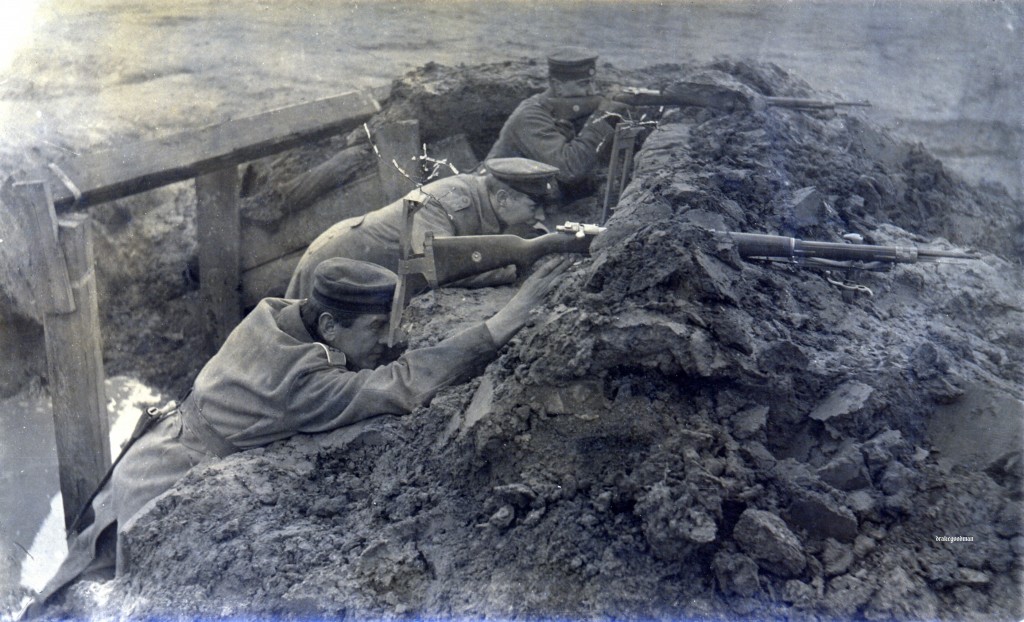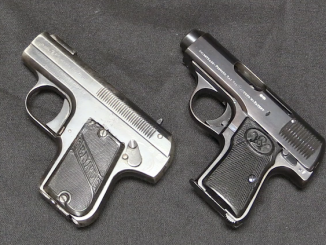
Vintage Saturday: Trench Periscope



Walther was founded as a rifle making company in the 1880s, and expanded into the flourishing market for semiautomatic pocket pistols around 1910. The Model 3 was the company’s first .32 ACP caliber pistol, and […]

German soldiers training with a Czech CZ30(t) machine gun, a refined Vickers gun used mostly for air service. Thanks to Beryl for the photo!

As Theodore Bergmann and Louis Schmeisser embarked on the process of perfecting and improving their production pistols, they used a numbering system to identify the different models that were made. There are also model years […]
© 2025 Forgotten Weapons.
Site developed by Cardinal Acres Web Development.

Uh oh… I expect the recoil to kick the periscope into his face! Periscope rifles did make sense when aiming, but how does one handle recoil of a full-power cartridge without securing the rifle? Or do we assume that this soldier is really using his head?
Better a periscope to the face than a bullet to the head.
I think we can safely assume this was a photograph of a demonstration of potential uses for the periscope, taken away from the front lines…
Given nobody has shot the chap on the end with his head over the parapet, or indeed the photographer.
So in use, one would have to secure the gun to something… Like a plank of wood, with a stick protruding from its underside to allow you to turn it etc.
Is the rifle staked into the ground? There is a brass knuckle looking piece of metal near the front of the sling.
That “brass knuckle looking thing” is the hilt of his bayonet, which is shoved vertically in the dirt. Maybe it is in use as a rest.
If that photo was taken in combat, I would not want to be the photographer.
The bayonet in front of him is a french Chassepot bayonet. The man in the middle seems to have some sort of very long ” magasin” on the place for the stripper clip….
Maybe it was a former French emplacement, now behind enemy lines…
No it isn’t. It is a German Seitengewehr 71 bayonet. They were floating around in decent numbers at the time. The sling is definitely looped around the bayonet with the rear swivel hooked onto the trigger guard in the parade position. Perfectly adequate to take up the recoil.
Upon further examination, it looks like the bayonet stuck in the ground normally resides in the scabbard hanging from the shooter’s belt.
Aye you can see an empty scabbard on his belt actually, well the bayonet was probably employed in this manner if the sling is sufficiently in contact with it which looks possible. As a potential implementation of using the periscope, without additional items being utilized to facilitate it’s practical use.
Modern bayonets aren’t so long and therefore I doubt if they would give sufficient anchorage, if used in the above configuration. If someone has say an AR which accepts a bayonet, perhaps they could replicate the system to test it. If it doesn’t work because of the bayonets length try making a rod which would fit through the hole in the blade horizontally, then bury this “anchor shape” possibly secure with rocks and engage the weapons sling with it again. You can get modern battlefield periscopes, contained in telescopic tubes for example. Affix one to the AR’s stock as shown via cable ties or something, try shooting a target.
Might prove to be a forgotten technique…
Or is that also a periscope device?… Can’t see it right…
Love to have one for my collection…
1916, I wonder what happened to those chaps poor fellows…
The rifles periscope kind of looks like it’s made out of a partially translucent plastic of some sort and it is a different shape than the other, great these old photos aren’t they nearly 100 years ago.
I really hope they survived the horrors of the time, although I’m frankly not optimistic about their chances.
The development timelines of cellulose acetate sheet and plexiglas (perspex) would not have lent themselves to general use in the First World War, the sole exceptions that I can think of being an early version of polymethyl methacrylate sheet ( which, while first formulated in Germany in 1877, did not see widespread acceptance as plexiglas until the early 1930’s ),or thick acetate film before the general commercial production of acetate sheet and rod came about (in 1927). Perhaps the periscope body’s material only appears to be semi-translucent in the photograph due to tricks of light and shadow, and is really of a more conventional material?
It’s most likely made out of wood or some kind of board. Wood would have been readily available. If you zoom to the full resolution of the scan on a good-sized display, it becomes fairly clear that it is not really translucent. The translucency effect is only visible in the lower part of the ‘scope, but the whole body is clearly from the same material.
Agreed. I had tried zooming in earlier, but still could not get as good a resolution as I would have preferred. I think it’s time for a new laptop :)!
As a follow-up, that other “more conventional” material I had mentioned earlier was probably a light-colored wood, hence the apparent trick of light and shadow.
the refraction system is attached to the butt fitting by a single screw/bolt/rivet? I suspect this allows it to move when rifle is recoiling,thereby not injuring the shooter? what do you think??
That particular model looks oddly cheap for a German sniperscope of World War I. I wonder how its optics were – in general, the Germans had much better periscopes and sniperscopes than the English did simply due to the quality of glass available. A book that covers the subject decently well (at least on the English side) is Dominating the Enemy: War in the Trenches 1914-1918″ by Anthony Saunders, along with other devices in how to survive trench warfare. Some of them quite brilliant and others… not so much.
Jeremy, this periscope wasn’t made in a factory, and this guy isn’t a sniper. The periscope was likely improvised at the front using wood, nails, and something for mirrors. Dedicated factory-made trench and rifle periscopes probably didn’t appear at the time, since nobody expected the war to last this long. Commanders higher up probably didn’t know much about the improvised optics and would have discouraged their use, calling their users cowards…
By 1916 Germany was well aware of the need for sniperscopes. And I’m not trying to imply he is a sniper per se, rather that at least the BEF referred to them as sniperscopes at the time. In the main the BEF were rather impressed with the quality of German sniperscopes and found their own designs wanting.
Branches on the two periscopes? (One is in front of the officer)
might be a glass plate negative, the branches look like cracks. Not sure tho, they are well placed 🙂
As a fan of “obsolete” forms of photography I would say: cracks on the glass plate negative for sure. Zoom in to full resolution of the scan and there is no doubt. Professional photographers in those days still used almost exclusively plate negatives instead of film, and one can see from the high resolution (for the period) that this was taken by a professional (or at least by a very good amateur) on a pretty large format negative.
I’m zooming in on these pretty darn closely and they are quite definitely twigs and not image artifacts. I mean, the one to the rear is even slightly out of focus! They are both clearly attached to the tops of the periscopes as well.
australian soldiers at Gallipoli used periscope rifles extensively. they had patterns worked out over time and they worked very well. they were more substantial than this chaps. images are on the australian war memorial site.
Thanks, Barry. Trust the Aussies to come up with something sturdy that works well in the field without a whole lot of fuss — very much the sort of practical solution to things that is in keeping with the Australian approach to problem solving.
Thanks Earl, if you type ‘beech periscope rifle’ or ‘gallipoli periscope rifle’ into the google images search you get plenty of nice period photographs.
The 1.0 version of Land Warrior is regarded by technohistorians as having been “somewhat buggy, in need of further development.”
both british and german soldiers used sight periscopes, but the rifle , was suported by an adisional stock in a lower level